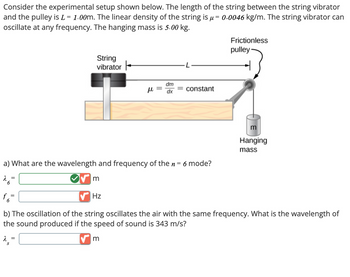
University Physics Volume 1
18th Edition
ISBN: 9781938168277
Author: William Moebs, Samuel J. Ling, Jeff Sanny
Publisher: OpenStax - Rice University
expand_more
expand_more
format_list_bulleted
Question
TW

Transcribed Image Text:Consider the experimental setup shown below. The length of the string between the string vibrator
and the pulley is L = 1.00m. The linear density of the string is μ = 0.0046 kg/m. The string vibrator can
oscillate at any frequency. The hanging mass is 5.00 kg.
String
vibrator
ト
dm
με
constant
dx
a) What are the wavelength and frequency of the n = 6 mode?
26=
m
Frictionless
pulley
Hanging
mass
f6-
Hz
b) The oscillation of the string oscillates the air with the same frequency. What is the wavelength of
the sound produced if the speed of sound is 343 m/s?
λ =
S
✓ m
Expert Solution
This question has been solved!
Explore an expertly crafted, step-by-step solution for a thorough understanding of key concepts.
This is a popular solution
Trending nowThis is a popular solution!
Step by stepSolved in 2 steps with 1 images

Knowledge Booster
Similar questions
- (a) If a submarine’s sonar can measure echo times with a precision of 0.0100 s, what is the smallest difference in distances it can detect? (Assume that the submarine is in the ocean, not in fresh water.) (b) Discuss the limits this time resolution imposes on the ability of the sonar system to detect the size and shape of the object creating the echo.arrow_forwardConsider two wave functions y1(x,t)=Asin(kxt) and y2(x,t)=Asin(kx+t+) . What is the wave function resulting from the interference of the two wave? (Hint: sin()=sincoscossin and =2+2 .)arrow_forwardShow that the wave equation in one dimension 2fx2=1v22ft2 Is satisfied by any doubly differentiable function of either the form f(x — vt) or f(x + vt).arrow_forward
- The density of a sample of water is =998.00kg/m3 and the bulk modulus is =2.15GPa . What is the speed of sound through the sample?arrow_forwardA microphone receiving a pure sound tone feeds an oscilloscope, producing a wave on its screen. If the sound intensity is originally 2.00105W/m2 , but is turned up until the amplitude increases by 30.0% , what is the new intensity?arrow_forwardCheck Your Understanding The wave function above is derived using a sine function. Can a cosine function be used instead?arrow_forward
- The source in Young’s experiment emits at two wavelengths. On the viewing screen, the fourth maximum for one wavelength is located at the same spot as the fifth maximum for the other wavelength. What is the ratio of the two wavelengths?arrow_forwardThe energy of a ripple on a pond is proportional to the amplitude squared. If the amplitude of the ripple is 0.1 cm at a distance from the source of 6.00 meters, what was the amplitude at a distance of 2.00 meters from the source?arrow_forwardCheck Your Understanding The equations for the wavelengths and the frequencies of the modes of a wave produced on a string: n=2nLn=1,2,3,4,5...andn=nv2L=nf1n=1,2,3,4,5... were derived by considering a wave on a string where there were symmetric boundary conditions of a node at each end. These modes resulted from two sinusoidal waves with identical characteristics except they were moving in opposite directions, confined to a region L with nodes required at both ends.Will the same equations work if there were symmetric boundary conditions with antinodes at each end? What would the normal modes look like for a medium that was free to oscillate on each end? Don’t worry for now if you cannot imagine such a medium, just consider two sinusoidal wave functions in a region of length L, with antinodes on each end.arrow_forward
- Sound is more effectively transmitted into a stethoscope by direct contact rather than through the air, and it is further intensified by being concentrated on the smaller area of the eardrum. It is reasonable to assume that sound is transmitted into a stethoscope 100 times as effectively compared with transmission though the air. What, then, is the gain in decibels produced by a stethoscope that has a sound gathering area of 15.0 cm2, and concentrates the sound onto two eardrums with a total area of 0.900 cm2 with an efficiency of 40.0% ?arrow_forwardA device called an insolation meter is used to measure the intensity of sunlight. It has an area of 100 cm2 and registers 6.50 W. What is the intensity in W/m2?arrow_forwardA stroboscope is set to flash every 8.00105 s. What is the frequency of the flashes?arrow_forward
arrow_back_ios
SEE MORE QUESTIONS
arrow_forward_ios
Recommended textbooks for you
 University Physics Volume 1PhysicsISBN:9781938168277Author:William Moebs, Samuel J. Ling, Jeff SannyPublisher:OpenStax - Rice University
University Physics Volume 1PhysicsISBN:9781938168277Author:William Moebs, Samuel J. Ling, Jeff SannyPublisher:OpenStax - Rice University Classical Dynamics of Particles and SystemsPhysicsISBN:9780534408961Author:Stephen T. Thornton, Jerry B. MarionPublisher:Cengage Learning
Classical Dynamics of Particles and SystemsPhysicsISBN:9780534408961Author:Stephen T. Thornton, Jerry B. MarionPublisher:Cengage Learning

 Principles of Physics: A Calculus-Based TextPhysicsISBN:9781133104261Author:Raymond A. Serway, John W. JewettPublisher:Cengage Learning
Principles of Physics: A Calculus-Based TextPhysicsISBN:9781133104261Author:Raymond A. Serway, John W. JewettPublisher:Cengage Learning Physics for Scientists and Engineers, Technology ...PhysicsISBN:9781305116399Author:Raymond A. Serway, John W. JewettPublisher:Cengage Learning
Physics for Scientists and Engineers, Technology ...PhysicsISBN:9781305116399Author:Raymond A. Serway, John W. JewettPublisher:Cengage Learning

University Physics Volume 1
Physics
ISBN:9781938168277
Author:William Moebs, Samuel J. Ling, Jeff Sanny
Publisher:OpenStax - Rice University

Classical Dynamics of Particles and Systems
Physics
ISBN:9780534408961
Author:Stephen T. Thornton, Jerry B. Marion
Publisher:Cengage Learning



Principles of Physics: A Calculus-Based Text
Physics
ISBN:9781133104261
Author:Raymond A. Serway, John W. Jewett
Publisher:Cengage Learning

Physics for Scientists and Engineers, Technology ...
Physics
ISBN:9781305116399
Author:Raymond A. Serway, John W. Jewett
Publisher:Cengage Learning